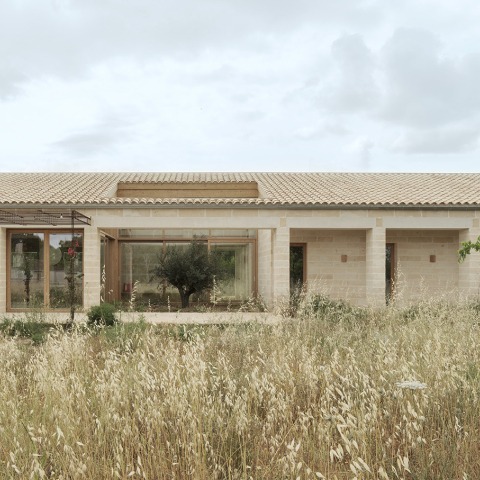
The project by Ernest Bordoy evokes the collective cultural imagination due to its use of local materials and traditional construction techniques, which, together with the analysis of the building's life cycle and its conscious approach to environmental impact, make the house an example of responsible architecture where a reduction in the contribution to global warming can be observed, a saving of numerous tons of CO2, etc.
Ca na Catalina prioritizes proximity and the local business network, just as it exalts the nearby landscape and the beauty of tradition while generating spaces that are conceived within the ship as a low body of sandstone that introduces the landscape to which it adapts into its interior and whose communication is maintained constant through the openings from the main room or the patio and the other rooms.

Ca na Catalina by Ernest Bordoy. Photograph by Luís Díaz.
Project description by Ernest Bordoy
The project begins with the recognition of the surroundings. With that goal in mind the typology is determined: a dairy farm, typical from the Majorcan rural landscape. It is characterized by being an elongated one-floor building, with a regular rhythm of openings and pillars. The second step in terms of integration into the landscape is the choice of the façade material. The use of marés (local lime stone) as a load-bearing wall and façade recovers the traditional construction technique while resulting in a more respectful relationship with its rural context.
The next step is the introduction of a patio in the center of the building. This patio separates the most public area from the bedroom area, generating at the same time the access area directly oriented towards the patio. Next, three auxiliary service bodies are arranged, the kitchen and the fireplace to the living room, and the window-desk in the main room. The bathrooms and secondary rooms are conceived as a low sandstone body within the main building, between the patio and the main room.

Four considerations come into play when choosing the remaining materials and construction systems:
The first one, the environmental impact. Thus, it was decided to work with natural and local materials. This allowed to have a low ecological footprint. The life cycle assessment (LCA) of the building reveals that the building's contribution to global warming has been reduced by 30% compared to an equivalent building with conventional materials. This represents a saving of 21.5 tons of CO2 eq (nearly the same as traveling around the earth 3 times in a gasoline car). marés walls and partitions represent half the emissions compared to a concrete block and drywall solution.
The second one, the health of future users, avoiding, for example, coatings and paints that have volatile organic compounds (VOC) or insulation derived from petroleum, choosing instead natural materials (natural cork insulation under the roof and recycled cotton between the façade walls). The few walls that are plastered, are made with lime mortar, manufactured 15km away from the site. Lime mortar has great bactericidal and fungicidal qualities and at the same time helps regulate the humidity of the environment.

The third, the cultural reference. The recovery of a traditional Majorcan construction technique evokes the collective cultural imagination. If other materials and finishes are used throughout the world, endemic construction techniques allow architecture to move away from a decontextualized homogeneity.
The fourth, the social impact. In this sense, prioritizing local products helps to stimulate the local economy by favoring the local business network. But not just any business network, but precisely those which are sensitive to the other three issues. An example is the use of glazed clay tiles, fired with biomass ovens and manufactured 15km from the work site.




















































